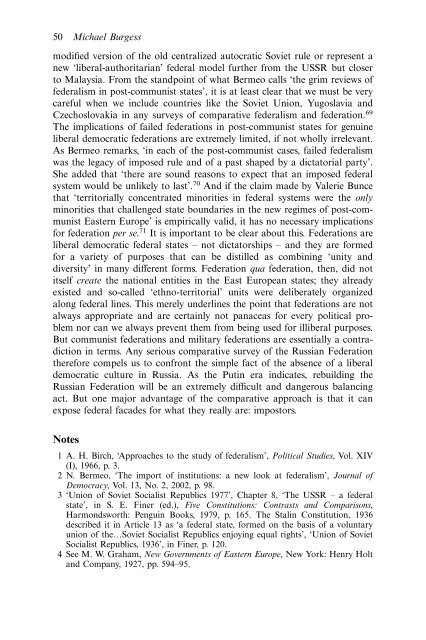Federalism and Local Politics in Russia
Federalism and Local Politics in Russia
Federalism and Local Politics in Russia
Create successful ePaper yourself
Turn your PDF publications into a flip-book with our unique Google optimized e-Paper software.
50 Michael Burgessmodified version of the old centralized autocratic Soviet rule or represent anew ‘liberal-authoritarian’ federal model further from the USSR but closerto Malaysia. From the st<strong>and</strong>po<strong>in</strong>t of what Bermeo calls ‘the grim reviews offederalism <strong>in</strong> post-communist states’, it is at least clear that we must be verycareful when we <strong>in</strong>clude countries like the Soviet Union, Yugoslavia <strong>and</strong>Czechoslovakia <strong>in</strong> any surveys of comparative federalism <strong>and</strong> federation. 69The implications of failed federations <strong>in</strong> post-communist states for genu<strong>in</strong>eliberal democratic federations are extremely limited, if not wholly irrelevant.As Bermeo remarks, ‘<strong>in</strong> each of the post-communist cases, failed federalismwas the legacy of imposed rule <strong>and</strong> of a past shaped by a dictatorial party’.She added that ‘there are sound reasons to expect that an imposed federalsystem would be unlikely to last’. 70 And if the claim made by Valerie Buncethat ‘territorially concentrated m<strong>in</strong>orities <strong>in</strong> federal systems were the onlym<strong>in</strong>orities that challenged state boundaries <strong>in</strong> the new regimes of post-communistEastern Europe’ is empirically valid, it has no necessary implicationsfor federation per se. 71 It is important to be clear about this. Federations areliberal democratic federal states – not dictatorships – <strong>and</strong> they are formedfor a variety of purposes that can be distilled as comb<strong>in</strong><strong>in</strong>g ‘unity <strong>and</strong>diversity’ <strong>in</strong> many different forms. Federation qua federation, then, did notitself create the national entities <strong>in</strong> the East European states; they alreadyexisted <strong>and</strong> so-called ‘ethno-territorial’ units were deliberately organizedalong federal l<strong>in</strong>es. This merely underl<strong>in</strong>es the po<strong>in</strong>t that federations are notalways appropriate <strong>and</strong> are certa<strong>in</strong>ly not panaceas for every political problemnor can we always prevent them from be<strong>in</strong>g used for illiberal purposes.But communist federations <strong>and</strong> military federations are essentially a contradiction<strong>in</strong> terms. Any serious comparative survey of the <strong>Russia</strong>n Federationtherefore compels us to confront the simple fact of the absence of a liberaldemocratic culture <strong>in</strong> <strong>Russia</strong>. As the Put<strong>in</strong> era <strong>in</strong>dicates, rebuild<strong>in</strong>g the<strong>Russia</strong>n Federation will be an extremely difficult <strong>and</strong> dangerous balanc<strong>in</strong>gact. But one major advantage of the comparative approach is that it canexpose federal facades for what they really are: impostors.Notes1 A. H. Birch, ‘Approaches to the study of federalism’, Political Studies, Vol. XIV(I), 1966, p. 3.2 N. Bermeo, ‘The import of <strong>in</strong>stitutions: a new look at federalism’, Journal ofDemocracy, Vol. 13, No. 2, 2002, p. 98.3 ‘Union of Soviet Socialist Republics 1977’, Chapter 8, ‘The USSR – a federalstate’, <strong>in</strong> S. E. F<strong>in</strong>er (ed.), Five Constitutions: Contrasts <strong>and</strong> Comparisons,Harmondsworth: Pengu<strong>in</strong> Books, 1979, p. 165. The Stal<strong>in</strong> Constitution, 1936described it <strong>in</strong> Article 13 as ‘a federal state, formed on the basis of a voluntaryunion of the…Soviet Socialist Republics enjoy<strong>in</strong>g equal rights’, ‘Union of SovietSocialist Republics, 1936’, <strong>in</strong> F<strong>in</strong>er, p. 120.4 See M. W. Graham, New Governments of Eastern Europe, New York: Henry Holt<strong>and</strong> Company, 1927, pp. 594–95.
















